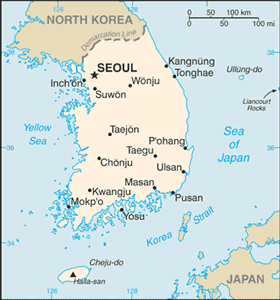The Geography of Korea, South
The Geography of Korea, South
Korean Geography
Location: Eastern Asia, southern half of the Korean Peninsula bordering the Sea of Japan and the Yellow Sea
Geographic coordinates: 37 00 N, 127 30 E
Map references: Asia
Area: total: 98,480 sq km land: 98,190 sq km water: 290 sq km
Area - comparative: slightly larger than Indiana
Land boundaries: total: 238 km border countries: North Korea 238 km
Coastline: 2,413 km
Maritime claims: territorial sea: 12 nm; between 3 nm and 12 nm in the Korea Strait contiguous zone: 24 nm exclusive economic zone: 200 nm continental shelf: not specified
Climate: temperate, with rainfall heavier in summer than winter
Terrain: mostly hills and mountains; wide coastal plains in west and south
Elevation extremes: lowest point: Sea of Japan 0 m highest point: Halla-san 1,950 m
Natural resources: coal, tungsten, graphite, molybdenum, lead, hydropower potential
Land use: arable land: 16.58% permanent crops: 2.01% other: 81.41% (2005)
Irrigated land: 8,780 sq km (2003)
Natural hazards: occasional typhoons bring high winds and floods; low-level seismic activity common in southwest
Environment - current issues: air pollution in large cities; acid rain; water pollution from the discharge of sewage and industrial effluents; drift net fishing
Environment - international agreements: party to: Antarctic-Environmental Protocol, Antarctic-Marine Living Resources, Antarctic Treaty, Biodiversity, Climate Change, Climate Change-Kyoto Protocol, Desertification, Endangered Species, Environmental Modification, Hazardous Wastes, Law of the Sea, Marine Dumping, Ozone Layer Protection, Ship Pollution, Tropical Timber 83, Tropical Timber 94, Wetlands, Whaling signed, but not ratified: none of the selected agreements
Geography - note: strategic location on Korea Strait


